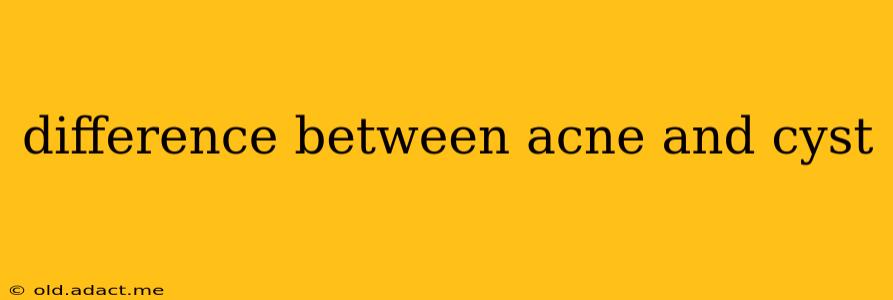Acne and cysts are both skin conditions that can cause bumps and blemishes, leading to confusion about their differences. While they share some similarities in appearance, understanding their underlying causes and characteristics is crucial for effective treatment. This comprehensive guide will delve into the key distinctions between acne and cysts, helping you identify and address each condition appropriately.
What is Acne?
Acne vulgaris, commonly known as acne, is a common skin condition characterized by the clogging of hair follicles with oil, dead skin cells, and bacteria. This clogging leads to the formation of various lesions, including:
- Comedones (blackheads and whiteheads): These are the most basic form of acne, caused by clogged pores. Blackheads appear dark due to oxidation of melanin, while whiteheads are covered by skin.
- Papules and pustules: These are inflamed lesions. Papules are small, red bumps, while pustules are pus-filled pimples.
- Nodules and cysts: These are the most severe forms of acne, involving deeper inflammation and often causing significant pain and scarring. It's important to note that while acne can include cysts, a cyst is not itself acne.
What is a Cyst?
A cyst is a sac-like structure under the skin filled with fluid, semi-solid, or other material. Unlike acne, cysts aren't necessarily related to oil production or hair follicles. They can form in various parts of the body and can be caused by several factors, including:
- Blocked ducts: Similar to acne, a blocked duct can lead to cyst formation, but the underlying cause and contents are different.
- Infection: Infections can also trigger cyst development.
- Genetic factors: Some cysts are hereditary.
- Inflammation: Chronic inflammation can contribute to cyst formation.
What are the Key Differences Between Acne and a Cyst?
| Feature | Acne | Cyst |
|---|---|---|
| Cause | Clogged hair follicles, oil, bacteria | Blocked duct, infection, genetic factors, inflammation |
| Location | Primarily face, back, chest | Can occur anywhere on the body |
| Appearance | Comedones, papules, pustules, nodules | Single, often larger, lump or bump; may be fluctuant (movable) |
| Pain | Can range from mild to severe | Often painful, especially if infected |
| Size | Varies greatly | Usually larger than acne lesions |
| Depth | Varies, from superficial to deep | Generally deeper than most acne lesions |
| Treatment | Topical treatments, oral medications | Drainage (by a medical professional), antibiotics, surgical removal |
How Can I Tell the Difference?
Differentiating between acne and a cyst can be challenging, especially for severe acne. If you're unsure, consult a dermatologist. They can accurately diagnose the condition and recommend the appropriate treatment. Key distinguishing features to consider include:
- Size and depth: Cysts are typically larger and deeper than most acne lesions.
- Pain: Cysts are often significantly more painful than typical acne.
- Appearance: Cysts usually appear as a single, well-defined lump, while acne often presents as multiple lesions.
- Location: While acne is common on the face, back, and chest, cysts can form anywhere on the body.
What is the treatment for acne?
Treatment for acne depends on the severity of the condition. Options include:
- Over-the-counter topical treatments: These include benzoyl peroxide and salicylic acid, which help kill bacteria and unclog pores.
- Prescription topical treatments: Retinoids, antibiotics, and azelaic acid are examples of prescription medications that can be more effective than over-the-counter options.
- Oral medications: For moderate to severe acne, oral antibiotics or isotretinoin (Accutane) may be prescribed.
What is the treatment for a cyst?
Cyst treatment varies depending on the type and location of the cyst. Options include:
- Observation: Some cysts may resolve on their own without treatment.
- Drainage: A dermatologist may drain a cyst using a needle.
- Antibiotics: If the cyst is infected, antibiotics may be necessary.
- Surgical removal: Large or persistent cysts may require surgical removal.
When should I see a doctor about acne or a cyst?
You should seek professional medical advice if:
- Your acne is severe or doesn't respond to over-the-counter treatments.
- You have a cyst that is large, painful, or infected.
- You have concerns about scarring.
Remember, this information is for general knowledge and shouldn't replace professional medical advice. Always consult a dermatologist for accurate diagnosis and treatment of skin conditions.
